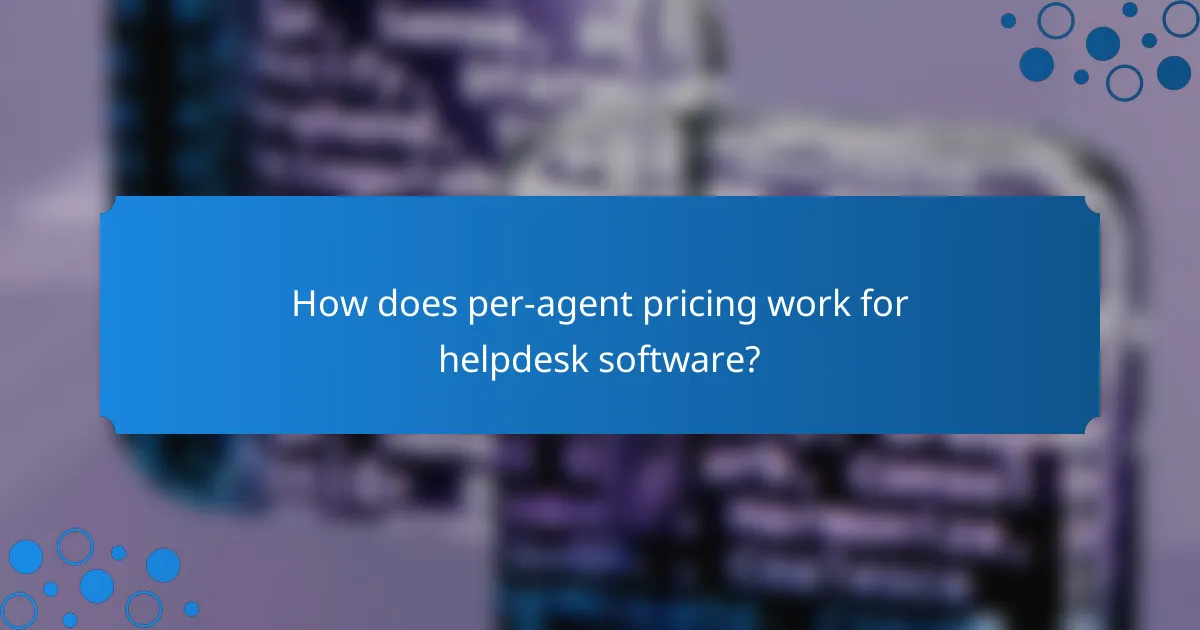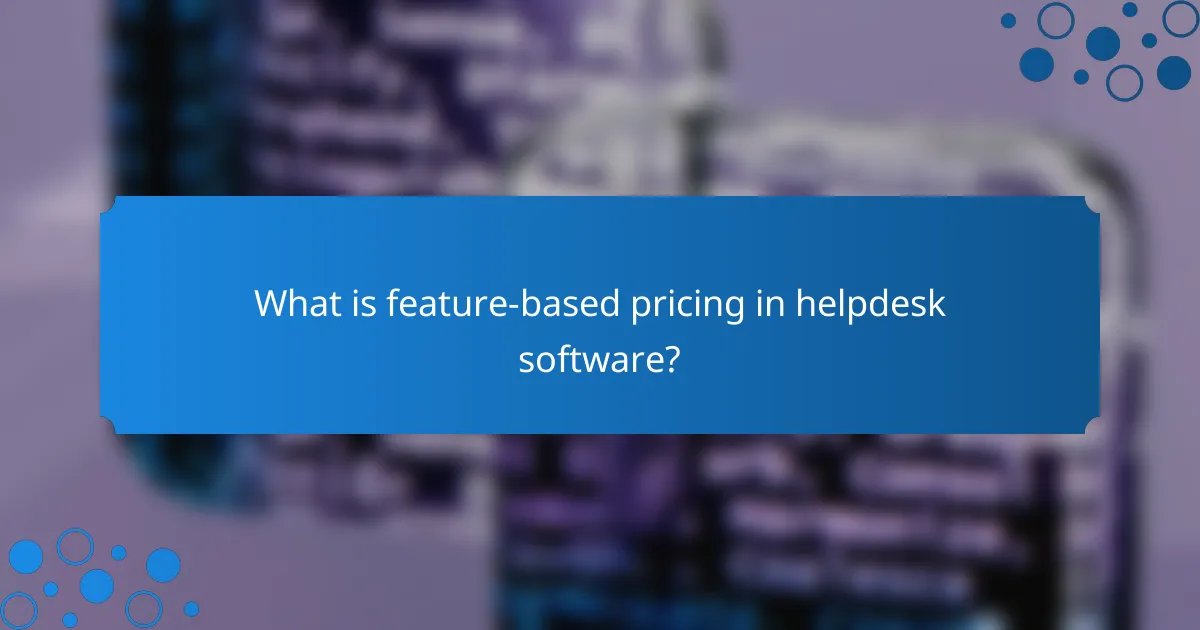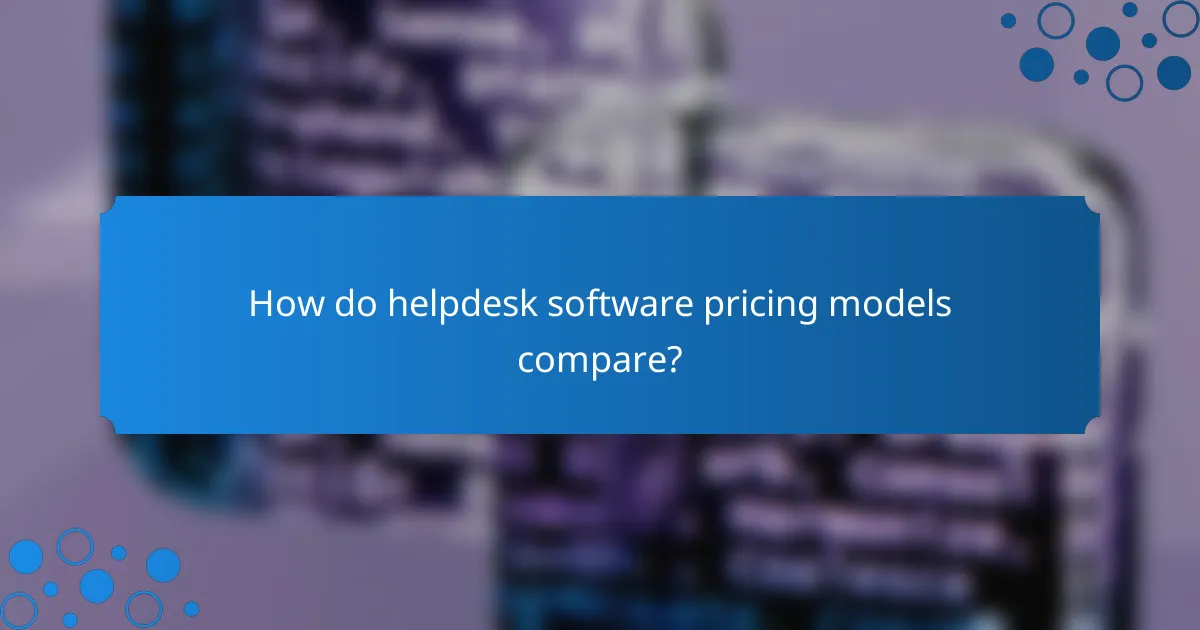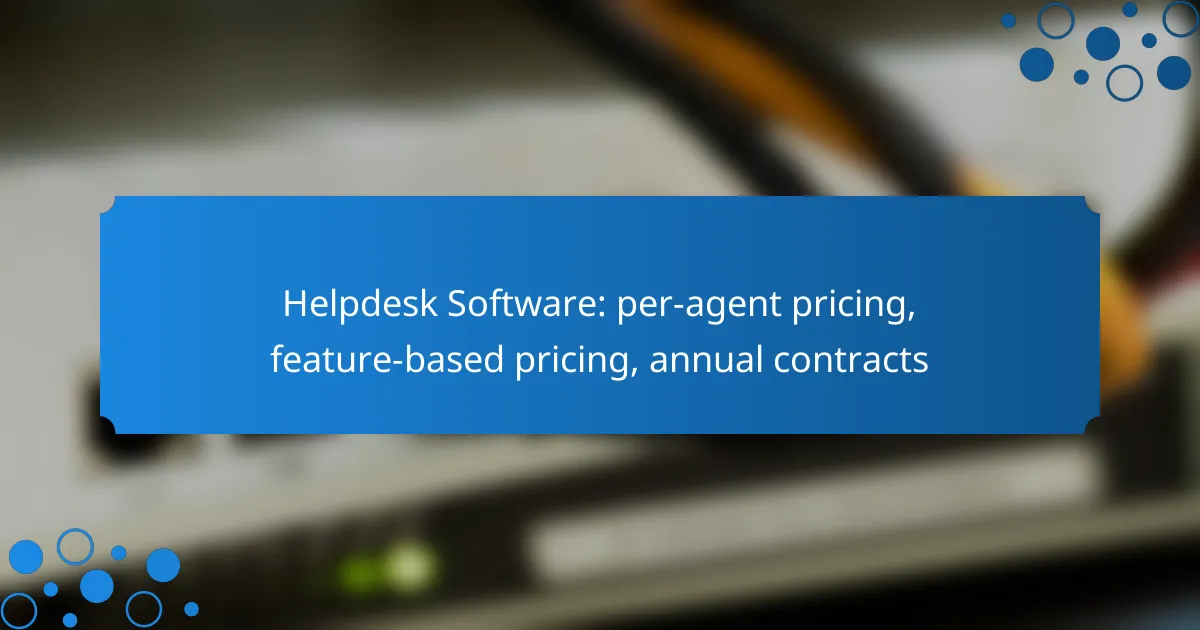When selecting helpdesk software, businesses in the UK should consider various pricing models, including per-agent pricing and feature-based pricing, as well as the implications of annual contracts. Per-agent pricing allows companies to align costs with the number of agents, providing flexibility as team sizes change. Meanwhile, feature-based pricing enables organizations to choose plans based on the specific functionalities they require, ensuring a more customized solution that fits their operational needs and budget.

What are the best helpdesk software options in the UK?
The best helpdesk software options in the UK offer a variety of pricing models and features tailored to different business needs. Key considerations include per-agent pricing, feature-based pricing, and the terms of annual contracts, which can significantly impact overall costs and functionality.
Zendesk
Zendesk is a widely used helpdesk solution known for its robust features and scalability. It offers a per-agent pricing model, which can be beneficial for businesses that prefer to pay only for the agents they need, making it suitable for small to large enterprises.
Key features include ticket management, multi-channel support, and extensive reporting tools. However, businesses should be aware that costs can increase as more features are added or as the team grows, so careful planning is essential.
Freshdesk
Freshdesk provides a flexible pricing structure that includes both per-agent and feature-based options. This allows businesses to choose a plan that best fits their operational needs and budget constraints.
With features like automation, collaboration tools, and a user-friendly interface, Freshdesk is ideal for teams looking to enhance productivity. Additionally, it offers a free tier for small teams, making it an attractive option for startups.
Help Scout
Help Scout focuses on simplicity and customer experience, offering a per-agent pricing model that is straightforward and easy to manage. This software is particularly suited for small to medium-sized businesses that prioritize personal customer interactions.
Its key features include shared inboxes, customer profiles, and reporting capabilities. Businesses should consider the limitations on integrations and advanced features in lower-tier plans, which may necessitate upgrading as they grow.
Zoho Desk
Zoho Desk offers a feature-rich helpdesk solution with both per-agent and feature-based pricing options. This flexibility allows businesses to tailor their subscriptions based on specific needs and budget considerations.
Notable features include AI-driven automation, ticket routing, and a comprehensive knowledge base. The platform is particularly advantageous for companies already using other Zoho products, as it integrates seamlessly within the ecosystem.
Intercom
Intercom is known for its focus on customer engagement and communication, offering a pricing model that can be based on features and usage rather than strictly per-agent. This can be advantageous for businesses that prioritize customer interaction over traditional ticketing systems.
Key features include live chat, automated messaging, and customer segmentation. However, businesses should be mindful of the potentially higher costs associated with advanced features, which can add up quickly depending on usage levels.

How does per-agent pricing work for helpdesk software?
Per-agent pricing for helpdesk software charges businesses based on the number of agents using the system. This model allows companies to scale their costs with their workforce, making it easier to manage budgets as team sizes fluctuate.
Cost per user model
The cost per user model typically involves a fixed monthly or annual fee for each agent who accesses the helpdesk software. Prices can range from around $15 to $100 per agent per month, depending on the features included. Businesses should evaluate their needs to determine how many agents will require access and what level of service is necessary.
Some providers offer tiered pricing, where the cost per agent decreases as the number of agents increases. This can incentivize larger teams to adopt the software while keeping costs manageable.
Benefits of per-agent pricing
One of the main benefits of per-agent pricing is its straightforwardness; businesses only pay for the agents they need. This model allows for flexibility, enabling companies to add or remove agents based on seasonal demands or project requirements without incurring significant penalties.
Additionally, per-agent pricing often includes access to essential features, ensuring that all agents have the tools they need to provide effective support. This can lead to improved customer satisfaction and streamlined operations, as each agent can utilize the same platform and resources.

What is feature-based pricing in helpdesk software?
Feature-based pricing in helpdesk software refers to a pricing model where the cost of the software is determined by the specific features and functionalities included in each plan. This approach allows businesses to select a package that aligns with their operational needs and budget, often leading to more tailored solutions.
Pricing tiers based on features
Helpdesk software typically offers multiple pricing tiers, each corresponding to a different set of features. Basic plans may include essential functionalities like ticket management and customer support, while higher tiers often provide advanced options such as automation, analytics, and integrations with other tools.
When evaluating pricing tiers, consider the size of your team and the volume of support requests. For example, a small business might find a basic plan sufficient, while a larger enterprise may require a premium tier to accommodate complex workflows and higher ticket volumes.
Examples of feature-based pricing
Many helpdesk software providers implement feature-based pricing. For instance, a popular platform might offer three tiers: a basic plan at around $15 per agent per month, a standard plan at approximately $30, and a premium plan at about $50. Each tier would unlock progressively more advanced features.
Another example could be a helpdesk solution that charges $20 per agent per month for essential features, $40 for additional reporting and analytics, and $60 for full customization and integrations. This structure allows businesses to choose a plan that fits their specific needs and budget constraints.

What are the advantages of annual contracts for helpdesk software?
Annual contracts for helpdesk software offer significant benefits, including cost savings and enhanced commitment from both the provider and the user. By opting for a yearly contract, businesses can often secure better pricing and ensure consistent support throughout the year.
Cost savings with annual contracts
One of the primary advantages of annual contracts is the potential for cost savings. Many helpdesk software providers offer discounts for customers who commit to a full year, which can range from 10% to 30% compared to monthly billing. This upfront payment can also help businesses better manage their budgets by locking in prices for the duration of the contract.
Additionally, annual contracts often include access to premium features or services that may not be available with monthly plans. This can enhance the overall value of the software, making it a more cost-effective choice in the long run.
Commitment benefits
Annual contracts foster a stronger commitment between the business and the helpdesk software provider. This long-term relationship can lead to improved customer support and more tailored service, as providers are incentivized to maintain high satisfaction levels over time. Businesses can expect better responsiveness and a more personalized approach to their needs.
Moreover, committing to an annual contract can encourage organizations to fully integrate the helpdesk software into their operations. This can lead to better utilization of features and ultimately improve overall efficiency and customer service quality.

What factors should you consider when choosing helpdesk software?
When selecting helpdesk software, consider integration capabilities, scalability options, pricing models, and feature sets. These factors will significantly impact your team’s efficiency and the overall customer support experience.
Integration capabilities
Integration capabilities refer to how well the helpdesk software can connect with other tools and platforms your organization uses. Look for software that seamlessly integrates with CRM systems, communication tools, and project management applications to streamline workflows.
For example, if your team relies on platforms like Slack or Salesforce, ensure the helpdesk software can easily connect with these services. This can reduce the need for manual data entry and improve response times.
Scalability options
Scalability options determine how well the helpdesk software can grow with your organization. Choose software that can accommodate an increasing number of agents and support requests without compromising performance.
Consider whether the pricing model allows for easy scaling, such as per-agent pricing or feature-based pricing. This flexibility can help you manage costs as your team expands, ensuring you only pay for what you need.

How do helpdesk software pricing models compare?
Helpdesk software pricing models typically fall into three main categories: per-agent pricing, feature-based pricing, and annual contracts. Each model has its advantages and considerations, making it essential to choose one that aligns with your business needs and budget.
Per-agent pricing
Per-agent pricing charges businesses based on the number of agents using the software. This model is straightforward and scales with your team size, making it easy to predict costs as you grow.
When considering per-agent pricing, evaluate how many agents will need access and whether your team is likely to expand. For small to medium-sized businesses, this model can be cost-effective, typically ranging from $15 to $50 per agent per month.
Feature-based pricing
Feature-based pricing allows businesses to pay for specific functionalities they need, rather than a flat rate for all features. This model can be beneficial for companies that require only certain capabilities, such as ticketing or reporting.
When choosing feature-based pricing, assess which features are essential for your operations. Pricing can vary widely, with basic packages starting around $10 per month, while advanced features may push costs to several hundred dollars monthly.
Annual contracts
Annual contracts involve committing to a yearly subscription, often at a discounted rate compared to monthly billing. This model can provide savings and ensure continuous access to the software without frequent renewals.
Before opting for an annual contract, consider your long-term needs and whether you can commit to a full year. Discounts for annual contracts can range from 10% to 30%, making them attractive for companies with stable requirements.
